It was only a matter of time before the anti-Hindu elements emerged from the gutter to exploit the horrific rape and murder of the 23 year old student in Delhi. The first was Sunny Hundal who used his platform in the Guardian to launch a tirade against the worship of the sacred feminine as providing “a convenient facade behind which there is endemic violence ingrained in Indian culture.”
Rape is the fault of Hinduism
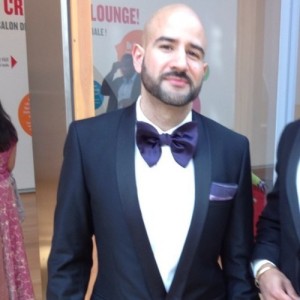 Hundal was safe in the knowledge that the leftist Guardian makes no secret of its contemptuous and colonialist style racism towards the very ancient culture and civilisation it is attacking. While everyone from uncompromising Christians and Muslims get their fair voice in this ‘liberal’ newspaper, Hindus are deliberately excluded unless they adopt the manner befitting to them which is that of inferior colonial subject. But then Hundal is not exactly new to this. Back in 2006 he supported the portrayal by Indian artist MF Hussain of Hindu goddesses having sex with animals being on public display. This was all under the banner of ‘freedom of expression’. A bit ironic then that Hundal now jumps on the bandwagon and criticises the sexual exploitation of women in Bollywood. The same freedom of expression argument could not now be used mutatis mutandis against him.
Hundal was safe in the knowledge that the leftist Guardian makes no secret of its contemptuous and colonialist style racism towards the very ancient culture and civilisation it is attacking. While everyone from uncompromising Christians and Muslims get their fair voice in this ‘liberal’ newspaper, Hindus are deliberately excluded unless they adopt the manner befitting to them which is that of inferior colonial subject. But then Hundal is not exactly new to this. Back in 2006 he supported the portrayal by Indian artist MF Hussain of Hindu goddesses having sex with animals being on public display. This was all under the banner of ‘freedom of expression’. A bit ironic then that Hundal now jumps on the bandwagon and criticises the sexual exploitation of women in Bollywood. The same freedom of expression argument could not now be used mutatis mutandis against him.
It is also disturbingly ironic for two other reasons. First could Hussain’s demeaning of the sacred feminine by showing bestiality as art not create an atmosphere which makes women into sexual objects? Secondly, before his death, Hundal’s artistic hero was offered citizenship of Qatar which practices hardline Wahhabism; hardly the most conducive ideology for artistic freedom.
 Hundal was soon joined by others. On 6 January 2013 BBC Radio 4 broadcast its usual religious affairs programme ‘Sunday’ just after 7am. Veteran reporter Edward Stourton used the opportunity to ask the rhetorical question if India’s majority religion of Hinduism was somehow to blame. Remember that this is the BBC we are talking about so Mr. Stourton had already decided that the answer is yes, it is to blame. Now remember that this organisation is the same broadcaster that likes to portray Hindu holy men as sexual deviants on complete lack of evidence yet repeats the same old false propaganda as facts years after they have been disproved. It is also the same outfit which on 17 February 2012 admitted it treated religions differently. This came from Mark Thompson, director-general of the BBC itself. So in keeping with its manner of treating Hinduism in a degrading manner, Stourton invited Dr. Atreyee Sen, Lecturer in Contemporary Religion and Conflict from the University of Manchester, to give her ‘expert’ opinion, which was of course that Hinduism was to blame.
Hundal was soon joined by others. On 6 January 2013 BBC Radio 4 broadcast its usual religious affairs programme ‘Sunday’ just after 7am. Veteran reporter Edward Stourton used the opportunity to ask the rhetorical question if India’s majority religion of Hinduism was somehow to blame. Remember that this is the BBC we are talking about so Mr. Stourton had already decided that the answer is yes, it is to blame. Now remember that this organisation is the same broadcaster that likes to portray Hindu holy men as sexual deviants on complete lack of evidence yet repeats the same old false propaganda as facts years after they have been disproved. It is also the same outfit which on 17 February 2012 admitted it treated religions differently. This came from Mark Thompson, director-general of the BBC itself. So in keeping with its manner of treating Hinduism in a degrading manner, Stourton invited Dr. Atreyee Sen, Lecturer in Contemporary Religion and Conflict from the University of Manchester, to give her ‘expert’ opinion, which was of course that Hinduism was to blame.
 She may have put it diplomatically but that thrust was plain. In keeping with its policy of treating Hindus as lower than everyone else, the BBC had in fact invited the same academic on its religious affairs show on 10 September 2012. This was ‘Beyond Belief’ where along with Shaunaka Rishi Das (Director of the Oxford Centre for Hindu Studies) and Padma Anagol (Senior Lecturer in History at Cardiff University) they discussed ‘Women in Hinduism’. Here it was Shaunaka that actually showed the varied strands of opinion that exist. Yet Sen and Anagol were having none of it. When their ideological formation is examined this hardly comes as a surprise. Both Sen and Anagol are products of Jawaharlal Nehru University in Delhi which is heavily imbibed with Marxist thinking and therefore their holy prophet’s colonialist racist animosity towards Indian culture, civilisation and history. Yet these are the people the BBC constantly sees fit to invite on. However was it for any religion favoured by Mark Thompson for immunity from criticism we would have seen a very different approach.
She may have put it diplomatically but that thrust was plain. In keeping with its policy of treating Hindus as lower than everyone else, the BBC had in fact invited the same academic on its religious affairs show on 10 September 2012. This was ‘Beyond Belief’ where along with Shaunaka Rishi Das (Director of the Oxford Centre for Hindu Studies) and Padma Anagol (Senior Lecturer in History at Cardiff University) they discussed ‘Women in Hinduism’. Here it was Shaunaka that actually showed the varied strands of opinion that exist. Yet Sen and Anagol were having none of it. When their ideological formation is examined this hardly comes as a surprise. Both Sen and Anagol are products of Jawaharlal Nehru University in Delhi which is heavily imbibed with Marxist thinking and therefore their holy prophet’s colonialist racist animosity towards Indian culture, civilisation and history. Yet these are the people the BBC constantly sees fit to invite on. However was it for any religion favoured by Mark Thompson for immunity from criticism we would have seen a very different approach.
Women in Leadership
 A major headache for anyone trying to blame Hinduism for the appalling treatment which women often face in India is to explain how this Hindu-majority country managed to elect one of the first female prime ministers anywhere in the world. Back in 1966 Indira Gandhi became prime minister of the world’s largest democracy. India therefore had an elected prime minister long before Margaret Thatcher enjoyed that position in 1979. Indeed when we surveys the political scene of South Asia we are struck just how many women have achieved the highest political office. Mrs. Gandhi was beaten into the position as the modern world’s first female head of government by Sirimavo Bandaranaike, who became prime minister of what was then Ceylon in 1960.
A major headache for anyone trying to blame Hinduism for the appalling treatment which women often face in India is to explain how this Hindu-majority country managed to elect one of the first female prime ministers anywhere in the world. Back in 1966 Indira Gandhi became prime minister of the world’s largest democracy. India therefore had an elected prime minister long before Margaret Thatcher enjoyed that position in 1979. Indeed when we surveys the political scene of South Asia we are struck just how many women have achieved the highest political office. Mrs. Gandhi was beaten into the position as the modern world’s first female head of government by Sirimavo Bandaranaike, who became prime minister of what was then Ceylon in 1960.
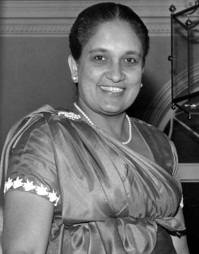 Bandaranaike held the position until 1965, and was re-elected again in 1970 when Ceylon became the Republic of Sri Lanka. She held this prime ministership until 1977 and was re-elected for a third term in 1994. Bandaranaike’s own daughter Chandrika Kamaratunga was elected prime minister in 1994 and also achieved the position of Sri Lanka’s first woman president later that year. If we exclude Han Myeong-sook of South Korea (which has no state religion and where Buddhism has been overtaken by Christianity) elected in 2006 and Nyam-Osoryn Tuyaa who was acting prime minister of Mongolia (a country where Buddhism was decimated by the communist dictatorship of Khorloogiin Choibalsan) for a short stint in 1999, then not until Yingluck Shinawatra was elected the first female prime minister of Thailand in 2011 had a modern Buddhist country had a woman in such a powerful position.
Bandaranaike held the position until 1965, and was re-elected again in 1970 when Ceylon became the Republic of Sri Lanka. She held this prime ministership until 1977 and was re-elected for a third term in 1994. Bandaranaike’s own daughter Chandrika Kamaratunga was elected prime minister in 1994 and also achieved the position of Sri Lanka’s first woman president later that year. If we exclude Han Myeong-sook of South Korea (which has no state religion and where Buddhism has been overtaken by Christianity) elected in 2006 and Nyam-Osoryn Tuyaa who was acting prime minister of Mongolia (a country where Buddhism was decimated by the communist dictatorship of Khorloogiin Choibalsan) for a short stint in 1999, then not until Yingluck Shinawatra was elected the first female prime minister of Thailand in 2011 had a modern Buddhist country had a woman in such a powerful position.
In 1988 Benazir Bhutto became the first women ever elected to lead a Muslim state. The second woman to hold this honour was the first ever female prime minister of Bangladesh, Khaleda Zia, elected in 1991.
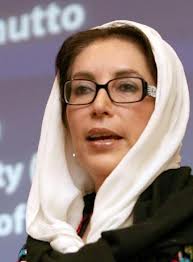 That Muslim country elected another female prime minister in 1996 when Sheikh Hasina won victory. Hasina again won the election in 2008 and is the current prime minister of Bangladesh. The other ‘Muslim’ women to have achieved this position outside of Pakistan and Bangladesh have been Megawati Sukarnoputri who became the first female president of Indonesia in 2001, Mame Madior Boye of Senegal in 2001, Atifete Jahjaga of Kosovo in 2011, and Tansu Çiller who was elected prime minister of Turkey in 1993. Turkey of course had tried since its formation as a modern western-style republic to get rid of the imprint of religion. Roza Otunbayeva may have become interim president of Kyrgyzstan in 2010 but she has openly stated that she has no religious beliefs.
That Muslim country elected another female prime minister in 1996 when Sheikh Hasina won victory. Hasina again won the election in 2008 and is the current prime minister of Bangladesh. The other ‘Muslim’ women to have achieved this position outside of Pakistan and Bangladesh have been Megawati Sukarnoputri who became the first female president of Indonesia in 2001, Mame Madior Boye of Senegal in 2001, Atifete Jahjaga of Kosovo in 2011, and Tansu Çiller who was elected prime minister of Turkey in 1993. Turkey of course had tried since its formation as a modern western-style republic to get rid of the imprint of religion. Roza Otunbayeva may have become interim president of Kyrgyzstan in 2010 but she has openly stated that she has no religious beliefs.
Now when we examine this a few inconvenient facts for the Hindu-baiters spring to mind. Could it be the Hindu influence and legacy of India’s neighbours which have actually created an environment where women can be elected to high office? This may at first sound laughable. But then consider how many times inequality and caste discrimination in Sri Lanka, Pakistan and Bangladesh is said to be a result of Hinduism being the one-time predominant religion in those countries. That is accepted as fact. So why not the concept that the sacred feminine was held in such high esteem so that when Islam or Buddhism took over then that legacy of respect remained imbibed in the cultural DNA of the masses. Even when we look outside India we see that Thailand and Indonesia retain powerful Hindu influences, notably in the form of the Ramayana, the subject of such mockery by Sen and Anagol on the BBC programme Beyond Belief because it apparently degraded women.
Yet such detractors would find it harder to argue against the next inconvenient fact. It will undoubtedly come as a surprise to many that there have actually been female heads of Islamic states in the pre-modern era. Shajar al-Durr was a female Turkic slave purchased by as-Salih Ayyub, who became Sultan of Egypt in 1249. The following year she was left widowed and became sultana, the first and only female ruler of the Islamic Maghreb and Middle East. The most Islamic part of Indonesia, the Sultanate of Aceh had several sultanas: Seri Ratu Nihrasyiah Rawangsa Khadiyu of Pase (1400-1427), Seri Ratu Ta’jul Alam Syafiatuddin Syah (1641-1675), her daughter Seri Ratu Nurul Alam Naqiatuddin Syah of Aceh (1675-1678), and her goddaughters Seri Ratu Zakiatuddin Inayat Syah and Seri Ratu Kamalat Syah (1688-1699). But it was India where a woman first ruled an Islamic state. Sultana Razia al-Din succeeded her father Iltutmish to the Sultanate of Delhi in 1236. She dressed like a man, sat in open durbar and led armies into battle.
 In fact she refused to be addressed as’ sultana’ because it meant wife or mistress of a sultan and thus would only answer only to the male appellation of ‘sultan’. Razia preferred to mingle with the masses rather than remain aloof and she encouraged tolerance of her majority Hindu subjects. The Sultana established schools, academies, centres for research, and public libraries that included the works of ancient philosophers along with the Quran and the traditions of Muhammad. Hindu works in the sciences, philosophy, astronomy, and literature were reportedly also studied in schools and colleges. In India there continued to be powerful women at court, notably during Mughal times when Nur Jahan was the effective power behind Emperor Jahangir, and in reality it was she who ruled the state. When the Mughals besieged Ahmednagar in 1595, one of the city’s defenders was an Indian female Muslim warrior, Chand Bibi. Also known as Chand Khatun or Chand Sultana, she was the daughter of Sultan Hussain Nizam Shah I of Ahmednagar and the wife of Ali Adil Shah I of the Bijapur Sultanate. Chand Bibi was herself effective ruler of Ahmednagar as regent of the state between 1596 and 1599, and had previously been regent of Bijapur.
In fact she refused to be addressed as’ sultana’ because it meant wife or mistress of a sultan and thus would only answer only to the male appellation of ‘sultan’. Razia preferred to mingle with the masses rather than remain aloof and she encouraged tolerance of her majority Hindu subjects. The Sultana established schools, academies, centres for research, and public libraries that included the works of ancient philosophers along with the Quran and the traditions of Muhammad. Hindu works in the sciences, philosophy, astronomy, and literature were reportedly also studied in schools and colleges. In India there continued to be powerful women at court, notably during Mughal times when Nur Jahan was the effective power behind Emperor Jahangir, and in reality it was she who ruled the state. When the Mughals besieged Ahmednagar in 1595, one of the city’s defenders was an Indian female Muslim warrior, Chand Bibi. Also known as Chand Khatun or Chand Sultana, she was the daughter of Sultan Hussain Nizam Shah I of Ahmednagar and the wife of Ali Adil Shah I of the Bijapur Sultanate. Chand Bibi was herself effective ruler of Ahmednagar as regent of the state between 1596 and 1599, and had previously been regent of Bijapur.
In fact in the princely state of Bhopal between 1819 and 1926, there was princely rule by women, the famous Begums of Bhopal. The rule of Begums gave the city its waterworks, railways, a postal system and a municipality constituted in 1907. In 1819, 18 year old Qudsia Begum (also known as Gohar Begum) took over the reins after the assassination of her husband and refused to comply with purdah. She also built the Jama Masjid and her beautiful palace the ‘Gohar Mahal'(also called Nazar Bagh) in Bhopal. In 1844 she was succeeded by her daughter Sikander Begum. Like her mother, she too never observed purdah and also fought many battles during her reign having trained in martial arts. In 1868 she was succeeded by Shah Jahan Begum after whom came the last female ruler, Sultan Kaikhusrau Jahan Begum in 1901.
So how to account for this? Why was it India where a woman ruled an Islamic state for the first time ever?
Hindu Goddesses Reflected Reality
 As consistent with the BBC’s policy to bait Hindus Edward Stourton gleefully related how women anti-rape activists in Delhi held up placards saying that wanted to be considered equal and not goddesses. This set the intended anti-Hindu atmospherics for Atreyee Sen to wade in and give her vitriolic opinions where she learnt by rote during formative years at Jawaharlal Nehru University. Of course the fact the goddesses such as Durga wield weapons and fight demons mattered not one iota, and was as irrelevant to Sen this time round as it was to both her and fellow academic comrade Anagol back in 2012. Again this brings up rather inconvenient facts. It should not surprise us that Razia became the first ever woman to rule an Islamic state when we realise that India was always the land of female warriors and queens. Until his death in 1986 AL Basham was one of the foremost authorities on ancient Indian history. His ‘The Wonder that was India’ was first published in in 1954 and became a seminal work on the subject. It was fitting that he completed his PhD and later taught at the School of Oriental and African Studies. From third revised edition of the late scholar’s work dated 2004, we find this on page 184:
As consistent with the BBC’s policy to bait Hindus Edward Stourton gleefully related how women anti-rape activists in Delhi held up placards saying that wanted to be considered equal and not goddesses. This set the intended anti-Hindu atmospherics for Atreyee Sen to wade in and give her vitriolic opinions where she learnt by rote during formative years at Jawaharlal Nehru University. Of course the fact the goddesses such as Durga wield weapons and fight demons mattered not one iota, and was as irrelevant to Sen this time round as it was to both her and fellow academic comrade Anagol back in 2012. Again this brings up rather inconvenient facts. It should not surprise us that Razia became the first ever woman to rule an Islamic state when we realise that India was always the land of female warriors and queens. Until his death in 1986 AL Basham was one of the foremost authorities on ancient Indian history. His ‘The Wonder that was India’ was first published in in 1954 and became a seminal work on the subject. It was fitting that he completed his PhD and later taught at the School of Oriental and African Studies. From third revised edition of the late scholar’s work dated 2004, we find this on page 184:
“If Sita, the heroine of the Ramayana, is invariably meek and compliant before her lord, Draupadi of the Mahabharata can round on her five husbands and reproach them in no uncertain terms. The Mauryan kings were guarded by amazons trained in the use of sword and bow, and the Greeks were impressed by the ferocity with which the women of some of the Panjab tribes aided their menfolk in resisting Alexander. In later times women sometimes took part in war, and the tradition was continued among the Rajputs until quite recently; there are numerous records of masterly and warlike widows resisting the enemies of their husbands – the last being the famous Rani of Jhansi, whose part in the Sepoy Revolt has made her a national heroine of modern India.”
Before the advent of Arab, Turkish and Afghan rulers India had several queens of note. In the tenth century Didda ruled Kashmir. In Warangal (Andhra Pradesh) there was Rudramama ruling from 1259 to 1288. In Orissa daughters often inherited the throne. In the south there were also powerful female figures. Akkadevi, sister of the Chalukya king Jayasimha II (1015-1042) was a provincial governor and fought battles. She was called Gunadabedangi, meaning “beauty of virtues. Kundavai, the elder sister of Chola king Rajaraja I took a seat alongside her brother. Umadevi, queen of Hoysala king Viraballala (1173-1220) led two campaigns against recalcitrant vassals.
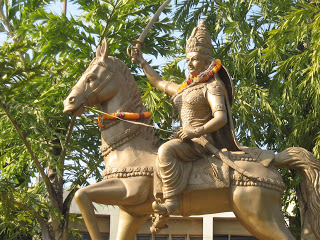 Rani Rudrama Devi (1259−1289AD) was one of the most prominent rulers of the Kakatiya dynasty, born as Rudramba, to King Ganapathideva. She defended her state from attacks by the Cholas and Yadavas. In doing so the queen earned the respect of her foes. An interesting fact to note is that she used the Shiva Tandavam dance with which to train her soldiers. Rudrama Devi herself worshipped the goddesses Bhadrakali, Ekaveera and Padmakshi. Marco Polo was moved to exalt her greatness as a queen. On her death Prataparudradeva II ( 1296-1323) son of her daughter Mummadamma succeeded to the throne.
Rani Rudrama Devi (1259−1289AD) was one of the most prominent rulers of the Kakatiya dynasty, born as Rudramba, to King Ganapathideva. She defended her state from attacks by the Cholas and Yadavas. In doing so the queen earned the respect of her foes. An interesting fact to note is that she used the Shiva Tandavam dance with which to train her soldiers. Rudrama Devi herself worshipped the goddesses Bhadrakali, Ekaveera and Padmakshi. Marco Polo was moved to exalt her greatness as a queen. On her death Prataparudradeva II ( 1296-1323) son of her daughter Mummadamma succeeded to the throne.
In northern Kerala folklore holds that during the sixteenth century there lived the female warrior Attummanammel Unniyarcha of the Chekavars. She was trained in the arts of the kalari, and an expert at wielding the urumi, a flexible sword used in kalaripayat. She saved the women of her village from being forcibly kidnapped by a rival community. Unniyarcha is still praised for her bravery and beauty in Vadakkan Pattukal. She is considered as a heroine and symbol of female ability in Malayalee women through songs and chronicles have kept the legend alive.
From Karnataka there was Belawadi Mallamma, the rave warrior queen of Belawadi who fought the Marathas and later the British. Maratha troops captured her and brought her to Shivaji. He praised her and said “I made a mistake Ma..! Kindly forgive me…I don’t want your kingdom”, then released her.
 There are contrasting views as to how women were treated in ancient India. Some scholars contend that during the Vedic period women enjoyed equal status in many areas and it was only later that their status degraded. Works by ancient Indian grammarians such as Patanjali and Katyayana suggest that women were educated and some Rig vedic verses suggest that the women married at a mature age, probably free to select their husband. Scriptures such as Rig Veda and Upanishads mention several women sages and seers, notably Gargi and Maitreyi. Gargi Vachaknavi is mentioned in the Sixth and the Eighth Brahmana of Brihadaranyaka Upanishad. Here the brahmayajna, a philosophic congress is organised by King Janaka of Videha. She challenged the sage Yajnavalkya with perturbing questions on the atman (human spiritual essence) which is recorded in the text known as the Yoga Yajnavalkya. Gargi composed several hymns that questioned the origin of all existence and is an author of Gargi Samhita. Maitreyi was the wife of Sage Yajnavalkya. The Rig Veda contains about one thousand hymns, of which about ten are accredited to her. Then there is Ghosha who has two entire hymns of the tenth book, each containing 14 verses, assigned to her name.
There are contrasting views as to how women were treated in ancient India. Some scholars contend that during the Vedic period women enjoyed equal status in many areas and it was only later that their status degraded. Works by ancient Indian grammarians such as Patanjali and Katyayana suggest that women were educated and some Rig vedic verses suggest that the women married at a mature age, probably free to select their husband. Scriptures such as Rig Veda and Upanishads mention several women sages and seers, notably Gargi and Maitreyi. Gargi Vachaknavi is mentioned in the Sixth and the Eighth Brahmana of Brihadaranyaka Upanishad. Here the brahmayajna, a philosophic congress is organised by King Janaka of Videha. She challenged the sage Yajnavalkya with perturbing questions on the atman (human spiritual essence) which is recorded in the text known as the Yoga Yajnavalkya. Gargi composed several hymns that questioned the origin of all existence and is an author of Gargi Samhita. Maitreyi was the wife of Sage Yajnavalkya. The Rig Veda contains about one thousand hymns, of which about ten are accredited to her. Then there is Ghosha who has two entire hymns of the tenth book, each containing 14 verses, assigned to her name.
Vedic literature praises the birth of a scholarly daughter thus: “A girl also should be brought up and educated with great effort and care.” (Mahanirvana Tantra); and
“All forms of knowledge are aspects of Thee; and all women throughout the world are Thy forms.”
(Devi Mahatmya). Wonder why are these words not quoted more often?
The Rig Veda contains a scholarly conversation between Sage Agastya and his wife, Lopamudra. Rig Veda also has 10 hymns on Maitreyi, a famous philosopher. Then there is a large number of women sages – Godha, Vishwawra, Apala, Upanishad, Brahmjaya, Aditi, Indrani, Sarma, Romsha, Urvashi, Lopamudra, Yami, Shashwati, Sri, Laksha, to name but a few.
“The sun god follows the first illuminated and enlightened goddess Usha (dawn) in the same manner as men emulate and follow women.”,
says Athravaveda Samhita, Part 2, Kanda 27, sukta 107, sloka 5705.
 So we have to re-examine what even Basham termed the “ambivalent” attitude towards women in ancient India. On Beyond Belief both Sen and Anagol took issue with the meek and submissive role which they felt had been assigned to Sita. The Ramayana was taken to be indicative of Hindu culture as a whole. But is it really anti-woman? Is Sita really so subservient to Rama in this, and thereby the whole male gender. She was a strong-willed and a headstrong woman, one who successfully argued her case with Rama and her in-laws to follow Rama into exile. She could even be said to be the earliest embodiment of a single parent. At no point, does she seek assistance from her parents, or for that matter from Rama. Which brings us on nicely to the case of Ahalya who was also rescued by Lord Rama.
So we have to re-examine what even Basham termed the “ambivalent” attitude towards women in ancient India. On Beyond Belief both Sen and Anagol took issue with the meek and submissive role which they felt had been assigned to Sita. The Ramayana was taken to be indicative of Hindu culture as a whole. But is it really anti-woman? Is Sita really so subservient to Rama in this, and thereby the whole male gender. She was a strong-willed and a headstrong woman, one who successfully argued her case with Rama and her in-laws to follow Rama into exile. She could even be said to be the earliest embodiment of a single parent. At no point, does she seek assistance from her parents, or for that matter from Rama. Which brings us on nicely to the case of Ahalya who was also rescued by Lord Rama.
Ahalya refused to accept social exile for being raped. She was cheated into believing that she was having sex with her husband. Seen in this light how could it possibly have been her fault? She continued staying at the same Ashram, despite society’s censor. Ultimately, Lord Rama, came to her rescue and declared her blameless. Modern feminists may scoff at this and ask why exactly does Ahalya need a male’s certificate to be blameless? In that case too, remember that we are talking of Lord Vishnu one of the Hindu Gods, whose avatara was Rama himself taking earthly manifestation to correct injustice. Never did Ahalya seek anyone’s assistance in her fight against social ostracism. Finally, her husband is forced to return to her and not the other way around.
In the Ramayana we find the figure of Tara, married off to her brother-in-law, younger to her, after her husband was killed by the former. She was the widowed wife of Bali, who married Sugriva. Tara made Rama and Sugriva stand as a guarantee to her son’s succession for the dishonourable in which way they had killed her husband. She is a picture of diplomacy and resourcefulness, not submission. Finally there is Mondodari, wife of Ravana and figure of hate for Sen and Anagol on BBC Radio 4’s Beyond Belief. Yet she handles Ravana with great skill and diplomacy. During the war with Rama and Lakshmana, she gives Ravana sane advice with great care. Had Ravana followed her advice, he would not have lost his life.
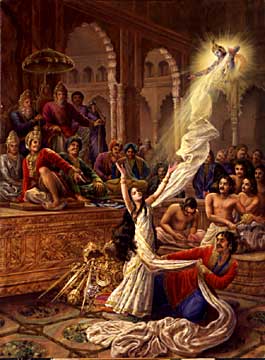 Draupadi’s disrobing attempt by Duhshasana is a lesson for any society. The attempt took place before Draupadi’s husbands and elders of the family. Draupadi’s anger and outburst at all of them is an eye-opener in itself. What is conveniently being forgotten is that Draupadi was a high-level of devotee of Shree Krishna and when everybody else fails her, she turns to Lord Krishna, who comes to her help. She would often lash out at her five husbands, her family, society and even at Krishna to remind them of their responsibility and duty. Hers was indeed the toughest task as she had to keep together five different personalities and focus their energies towards a great goal. Indeed, Draupadi was the embodiment of “karma – action”, the diametric opposite of submission.
Draupadi’s disrobing attempt by Duhshasana is a lesson for any society. The attempt took place before Draupadi’s husbands and elders of the family. Draupadi’s anger and outburst at all of them is an eye-opener in itself. What is conveniently being forgotten is that Draupadi was a high-level of devotee of Shree Krishna and when everybody else fails her, she turns to Lord Krishna, who comes to her help. She would often lash out at her five husbands, her family, society and even at Krishna to remind them of their responsibility and duty. Hers was indeed the toughest task as she had to keep together five different personalities and focus their energies towards a great goal. Indeed, Draupadi was the embodiment of “karma – action”, the diametric opposite of submission.
During the foreign invasions of India women resisted as much as men. In the thirteenth century Somadevi, daughter of Raja Maldeo of the Chahar Jatts who ruled in what is now Bikaner, fought in battle against the Delhi sultanate’s armies. Rampyari Gurjar led 40,000 women into battle against the invasions of Timur-e-lang in 1398. Rani Durgavati (October 5, 1524 – June 24, 1564) was born in the family of famous Rajput Chandel Emperor Keerat Rai, at the fort of Kalanjar. These Rajputs had been responsible for repulsing the depredations of Mahmud of Ghazni in the eleventh century. Also fighting Timur was Rampyari Gurjar who trained over 40,000 women to be warriors and fight alongside the men.
Rani Karnavati (died March 8, 1535), was a princess and temporary ruler from Bundi and grandmother to Rana Pratap. Babur had defeated a combined force of Rajputs and therefore Karnavati took up the regency in the name of her elder son Vikramjeet, a weak ruler. Defeated in battle she committed jauhar, self-immolation in fire.
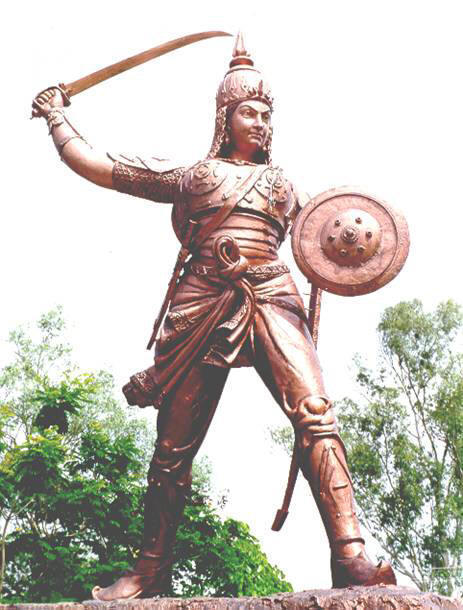 In 1556 Durgavati defeated the armies of Baz Bahadur, Sultan of Malwa. In 1562 is state was conquered by Mughal emperor Akbar. He sent Khwaja Abdul Majid Asaf Khan to vanquish her as well. Against overwhelming odds Durgavati nevertheless maintained that it was better to die respectfully than to live a disgraceful life. Leading the military charge herself she defeated the invading Mughal forces. Two years later she again faced these same foreign imperialist foes. Injured by an arrow and facing defeat she chose honourable suicide and stabbed herself.
In 1556 Durgavati defeated the armies of Baz Bahadur, Sultan of Malwa. In 1562 is state was conquered by Mughal emperor Akbar. He sent Khwaja Abdul Majid Asaf Khan to vanquish her as well. Against overwhelming odds Durgavati nevertheless maintained that it was better to die respectfully than to live a disgraceful life. Leading the military charge herself she defeated the invading Mughal forces. Two years later she again faced these same foreign imperialist foes. Injured by an arrow and facing defeat she chose honourable suicide and stabbed herself.
Oppressive rule by the Mughal colonialists led to a number of indigenous uprisings such as the Marathas, Jats, Rajputs, and Sikhs. In this Indian women played a major role yet their contribution has often been overlooked. When the forces of Aurangzeb besieged Guru Gobind Singh at Anandpur Sahib, some of his own followers deserted him. Gobind Singh asked them in writing to confess that “they are not his Sikhs anymore” and sign it. All forty Sikhs wrote their names on this document. Mai Bhago was distressed to hear that some of the Sikhs of her neighbourhood who had gone to Anandpur to fight for Guru Gobind Singh had deserted him under adverse conditions. Hearing her taunts, these Sikhs were ashamed at their deed. She rallied the deserters persuading them to meet the Guru and apologize to him and rode to the fortress herself. All forty men met martyrdom at the hands of Mughal soldiers and indeed only Mai Bhago and Gobind Singh survived. Guru Gobind Singh blessed those forty dead as the Forty Liberated Ones. He took into his care Mai Bhago who had also suffered injury in the battle. She thereafter stayed on as one of his bodyguards, in male attire. After the death of Guru Gobind Singh at Nanded in 1708, she retired at Jinvara in the Deccan.
Her hut in Jinvara has now been converted into Gurdwara Tap Asthan Mai Bhago. At Nanded, too, a hall within the compound of Takht Sachkhand. Sri Hazur Sahib marking the site of her residence is known as Bunga Mai Bhago. Sharan Kaur Pabla was not so fortunate. Guru Gobind Singh escaped the fort of Chamkaur on the night of December 22, 1705 and briefly stopped at Raipur on his way to Machhiwara. Here he asked Bibi Sharan Kaur Pabla to perform the last rites of the martyred Sikhs, which included two of his own sons; Sahibzada Ajit Singh and Sahibzada Jujhar Singh. Bibi Sharan Kaur Pabla performed the last rites of the two elder Sahibzadas and other Sikh warriors who had laid down their lives in the battle. According to one account, Bibi Sharan Kaur Pabla was so grief-stricken that she herself jumped in the funeral pyre and ended her life. According to another view she did not self-immolate but was slain by Mughul soldiers and thrown in the funeral pyre of Sahibzadas, when she and her other accomplices from Raipur, were caught cremating the bodies of Sahibzadas. Yet a third account claims she committed jauhar.
 Tarabai (1675–1761 AD) was a queen of the Marathas. Her husband was Chhatrapati Rajaram, son of Shivaji. She was the daughter of the famed Maratha general Hambirao Mohite, and the niece of Soyarabai, the second wife Chatrapati Shivaji. Tarabai was skilled in cavalry movement, and made strategic movements herself during wars. She personally led the war and continued the insurgency against the Mughals. When a truce was offered to the Mughals and then promptly rejected by the Mughal emperor, Tarabai continued Maratha resistance. When Rajaram died in 1700 she took charge of the army and state. By 1706 after a series of military disasters, the Mughals began retreating from Maratha territories. Umabaisaheb Khanderao Dabhade meanwhile was the only woman to become Sarsenapati or Commander-in-Chief of the Maratha Army in 1732. She built 470 steps on the hill to reach the temple of Goddess Saptashringi near Nasik in 1710.
Tarabai (1675–1761 AD) was a queen of the Marathas. Her husband was Chhatrapati Rajaram, son of Shivaji. She was the daughter of the famed Maratha general Hambirao Mohite, and the niece of Soyarabai, the second wife Chatrapati Shivaji. Tarabai was skilled in cavalry movement, and made strategic movements herself during wars. She personally led the war and continued the insurgency against the Mughals. When a truce was offered to the Mughals and then promptly rejected by the Mughal emperor, Tarabai continued Maratha resistance. When Rajaram died in 1700 she took charge of the army and state. By 1706 after a series of military disasters, the Mughals began retreating from Maratha territories. Umabaisaheb Khanderao Dabhade meanwhile was the only woman to become Sarsenapati or Commander-in-Chief of the Maratha Army in 1732. She built 470 steps on the hill to reach the temple of Goddess Saptashringi near Nasik in 1710.
In 1568 the Portuguese invaders who had taken Goa and laid waste to the surrounding areas turned their attention south to Ullal ruled by a queen, Rani Abbakka Chowta. Despite initial victories the Portuguese imperialists were repulsed. However in 1569 they returned and captured Abbakka. Yet even in prison she refused to remain passive. This queen has entered folklore and her story is told in song, the Karnataka folk theatre known as Yakshagana and the local dance of Bhuta Kola. Abbakka is portrayed as dark and good looking, always dressed in simple clothes like a commoner.
She is portrayed as a caring queen who worked late into the night dispensing justice. Legends also claim that Abbakka was the last known person to have the used the Agnivana (fire-arrow) in her fight against the Portuguese. Some accounts also claim that she had two equally valiant daughters who fought alongside her in her wars against the Portuguese. The “Veera Rani Abbakka Utsava” is an annual celebration held in her memory.
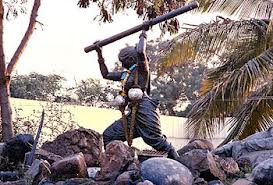 The Veera Rani Abbakka Prashasti(award) is awarded to distinguished women on the occasion. On January 15, 2003, the Indian postal department issued a special cover on Rani Abbakka while a bronze statue of the queen has been erected in Ullal and another in Bangalore. India’s First Inshore Patrol Vessel ICGS Rani Abbakka is named after her.
The Veera Rani Abbakka Prashasti(award) is awarded to distinguished women on the occasion. On January 15, 2003, the Indian postal department issued a special cover on Rani Abbakka while a bronze statue of the queen has been erected in Ullal and another in Bangalore. India’s First Inshore Patrol Vessel ICGS Rani Abbakka is named after her.
In the eighteenth century Hyder Ali of Mysore encountered a formidable female warrior called Onake Obavva in in the kingdom of Chitradurga of Karnataka. The city of Chitradurga was besieged by the troops of Hyder Ali(1720-1782) who saw Onake Obavva entering the Chitradurga fort through a hole in the rocks. He therefore sent his soldiers through that same hole. She noticed the enemies who were trying to enter the fort and hence used the Onake or pestle (a wooden long club meant for pounding paddy grains) to kill the soldiers one by one and quietly moved the dead, so that several of soldiers who entered through the hole were hit on head, without raising the suspicions of the rest of the troops. The guard, Obavva’s husband, returned from lunch, was shocked to see Obavva standing with a blood stained Onake and several of the enemies’ dead bodies around her. Considered to be the epitome of Kannada women pride, her heroic effort is depicted in a famous song-sequence in Nagarahavu film directed by Puttanna Kanagal. The sports stadium in Chitradurga – Veera Vanithe Onake Obavva Stadium, is named after her.
Continued
Defaming the Hindu Sacred Feminine ( Part 2 )

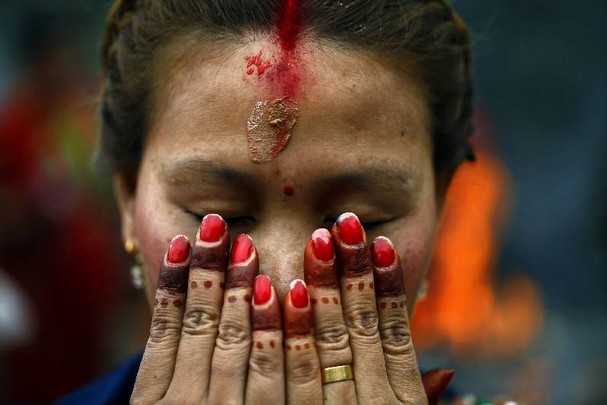









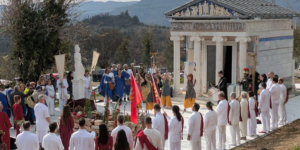




















Further each and every offensive speech/ writing/ conducts/ movies/ serial programs must be sued against in court of law. That will show the world that we will not tolerate abuse but we shall always remain withing the limits of law.
This will have salutary effect. Offenders will stop. Or flee like MF Hussain did.
There will always be stray dogs barking at some corner of the world or another. Should we be responding to every one of them?
But the issues as I see is that we and in turn our children are not inculcated in Hindu ethos. Hinduism theory and practice must both be emphasized in day to day life.
People of other religions in India must be sensitised to the fact that they are Muslims or Christians because their ancestors wee converted from Hindusim, most probably by violent means , like it happened during Goan Inquisition and Moghul rule or by unethical inducements like it happened in British rule and cases like Meenakshipuram in Ramanadapuram district Tamilnadu.
We must also pave a way for their return and re absorption in Hindu fold.Muslims who wish to come back must be especially protected from their barbaric and anti-constitutional religious laws of apostasy punishable with death.